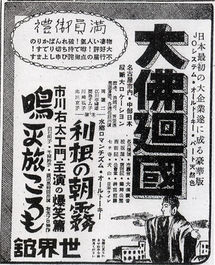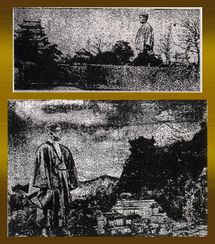Daibutsu Kaikoku (lost Japanese kaiju film; 1934): Difference between revisions
(Created page with "thumb|271x271px Also known under it's longer, translated title of ''The Giant Buddha Statue's Travel Through the Country'', '''''Daibatsu Kaikoku''''...") |
No edit summary |
||
| Line 1: | Line 1: | ||
[[File:Giant buddha.jpg|thumb| | [[File:Giant buddha.jpg|thumb|215px]] | ||
[[File:Bussag.jpg|thumb|215px]] | |||
Also known under it's longer, translated title of ''The Giant Buddha Statue's Travel Through the Country'', '''''Daibatsu Kaikoku''''' is one of Japan's earliest giant monster (if you count the statue as a monster) movies, coming out around the same time as the lost ''King Kong'' movies. | Also known under it's longer, translated title of ''The Giant Buddha Statue's Travel Through the Country'', '''''Daibatsu Kaikoku''''' is one of Japan's earliest giant monster (if you count the statue as a monster) movies, coming out around the same time as the lost ''King Kong'' movies. | ||
| Line 6: | Line 7: | ||
Planned to be the start of a multi-film series, the movie was only shown in a limited number of theaters and has since been lost. The only known images are from a magazine article. | Planned to be the start of a multi-film series, the movie was only shown in a limited number of theaters and has since been lost. The only known images are from a magazine article. | ||
==References== | ==References== | ||
Revision as of 17:29, 18 May 2015
Also known under it's longer, translated title of The Giant Buddha Statue's Travel Through the Country, Daibatsu Kaikoku is one of Japan's earliest giant monster (if you count the statue as a monster) movies, coming out around the same time as the lost King Kong movies.
Although the statue doesn't go around destroying cities, this is still a technically a Tokusatsu film, due to the focus on special effects. The story focuses on a giant Buddha statue, apparently 33 meters tall, as it comes to life and tours the country, mainly some tourist sights, before flying into the clouds to go to Tokyo. Known only by some descriptions in magazines, the movie had a few notable scenes, including: the statue striding over a train, resting his head on a 3-story building, and making a geisha girl dance in his palm. It also had some color sequences, taking place in heaven and hell.
Planned to be the start of a multi-film series, the movie was only shown in a limited number of theaters and has since been lost. The only known images are from a magazine article.
References
The article that provided all the information[1]

